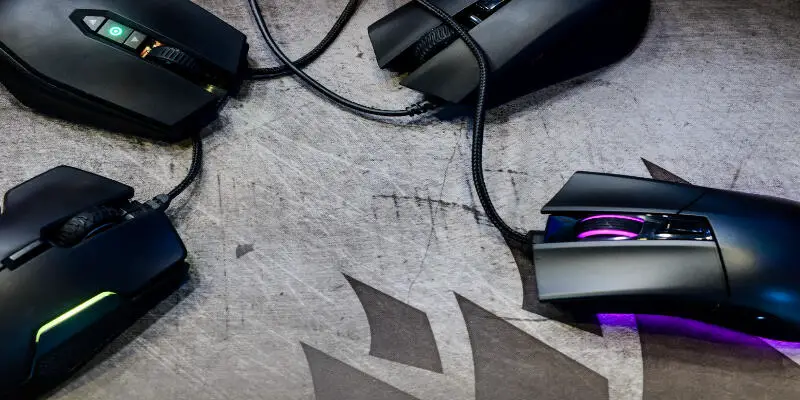Disclaimer: This post may contain affiliate links, meaning we get a small commission if you make a purchase through our links, at no cost to you. For more information, please visit our Disclaimer Page.
While working on your computer, you want a mouse that balances perfectly between accuracy and sensitivity. Optical mice have lower sensitivity as they use the LED technology, which only works on a mouse pad or a similar surface.
On the flip side, lacer mice are highly sensitive and can work on any surface. However, a lot of jittering goes around concerning their safety, especially for the eyes. So, can a laser mouse hurt your eyes?
Laser mouse emissions are not dangerous and therefore not harmful to your eyes. The class of laser used in mice is the class 1 laser, which is considered to be the safest laser of all other lasers. However, it’s essential to be cautious as some may be modified, causing harmful laser exposure.
Laser technology has been a game-changer in almost every industry. From kids’ toys to games, even laser pointers and computer mice are using the technology to optimize their work and function more efficiently.
This article takes a scientific approach to the safety of laser mice as their usage continues to rise among computer users.
Table of Contents
Can a Laser Mouse Hurt Your Eyes?
According to movements, a laser mouse uses laser beams to detect hand movements of a computer user and point items on the monitor screen.
Laser mice have been introduced into the market recently as the demand for higher sensitivity and precision has become more and more among computer users.
As mentioned earlier, the type of laser used in a computer mouse is the class 1 laser. This kind of laser is safe in all normal use conditions. In this case, the Maximum Permissible Exposure (MPE) is never exceeded.
Therefore, it’s considerable to say that a laser mouse cannot hurt your eyes.
Is The Laser On a Mouse Dangerous?
Lasers have different classifications in terms of maximum output power and their wavelength. These classes are class 1, class 1M, class 2, class 2M, class 3R, Class 3B, and Class 4. All these classes differ in wavelength and the maximum power output, and therefore, their effect on the eyes is different.
As already mentioned, the laser on a mouse is in the class 1 category, which means it’s not dangerous at all. The high power of the class 1 laser beams is held within the mouse enclosure, thus preventing radiation exposure to the user.
If the mouse is to be opened at any point, the laser shuts down so that there is no exposure to the person handling it.
If you look directly at the light at the bottom of your mouse for some time, your perception of color may change, or you may experience some blurriness with your eyes, but this effect only lasts for a few minutes.
This is because the light is not strong enough to cause permanent damage.
How Does a Laser Mouse Work?
Laser mice apply a method called Laser Doppler Velocimetry to generate movement. It involves the frequency shifting of light when it bounces off from a moving surface. Here’s how it works.
A laser mouse uses diodes that emit laser beams on the surface. The diodes are positioned at an angle to the surface to create tiny irregularities on the surface and cast shadows that the optics can sense and quickly pick up on them. The laser beams move at a particular frequency and bounce off as the mouse is moved across a surface. The light is reflected and returns to the laser diode.
The laser diode has photodiodes that perceive the reflected light in the form of blurry pictures, which it scans to try to find out what the computer user intends to do. The photodiodes can take over 1000 pictures in one second.
The light that reflects back interferes with the outgoing light, and that causes a beat frequency. The diode detects the beat frequency and then processes it into a velocity signal which triggers a position change.
These changes are transferred to the computer through the USB, and you can see the movements on the monitor screen.
The laser mouse makes smooth and accurate movements, constantly updating the position of the cursor. It can move well on any surface, meaning that you don’t need to have a mouse pad, like is the case when using an optical mouse.
This ability to work excellently on any surface makes a laser mouse an excellent go-anywhere tool.
What Happens If You Point a Laser Pointer in Your Eye?
Unlike other kinds of light that disperse from the source, a laser beam light focuses on one point and concentrates its energy in one place. This increases the chances of injury, mainly if the pointer outputs a high power.
A laser pointer gives out a power output of about 1-5 milliwatts. This power is strong enough to cause damage to the eye’s retina if stared into for more than 10 seconds.
Not only can it injure the retina, but also it can cause a permanent loss of vision. However, it’s impractical to expose the retina to that much light for a long time.
In less severe cases, a person can experience temporary blindness, where the light emitted by the laser pointer overpowers the eyes.
The person recovers after a few minutes, but it can still be dangerous, especially if the exposure is at night when the pupils are opened more widely.
Another risk comes in using unregulated laser pointers because they could emit more power than the one indicated. With the more substantial power, the eyes are at risk of getting permanent damage even after being exposed for a short period.
While chances of damaging your eyes looking into a laser pointer are low, it’s recommended that you exercise caution and keep your eyes safe. The FDA guidelines for safety when using laser pointers advise parents who would like to buy laser toys for their children to buy only those with class 1 laser.
There are other precautions you can take to ensure that you remain safe when using laser pointers. They include:
- Turn the laser pointer away from you when you are turning it on. The flashlight, when turning it on, may not be so good for your eyes.
- You may want to point the laser pointer towards your eyes, but it’s not a good idea. Therefore, never look into the laser pointer directly unless if it happens accidentally.
- Don’t point the laser pointer towards someone else. Protect those around you from the dangers of laser beams.
- Laser beams reflect on mirrors and other reflective surfaces, so ensure that you maintain the same safety guidelines as those of direct laser light.
- When purchasing laser pointers, ensure that you get them from reliable providers to ensure that the laser emitter is not tampered with. A modified laser pointer can produce more power, thus posing a risk to the user and the people around them.
If, by any chance, you look into a laser pointer and you feel a change in your eyes that lasts longer than a few minutes, do not hesitate to let the doctor check it.
Which is Better: Optical or Laser Mouse?
Choosing between an optical mouse and a laser mouse can be a little brain-churning, as the optical mouse has received an upgrade and functions as well as a laser mouse. However, to know which is better, we look at how they compare with each other in terms of sensitivity, surface compatibility, pricing, and gaming capabilities.
Sensitivity
Laser mice are highly sensitive and tend to collect even useless data from the surface they are moving on. This can be troublesome, especially if you’re using the mouse on a sketching tool like Adobe Illustrator.
It’ll tend to draw irregular image lines because it can detect invisible ‘hills and valleys of the surface it’s moving on. You’ll require a smooth surface with very few details to have a better experience when using it.
On the flip side, an optical mouse may work better and produce a much more consistent image as their accuracy level is not too high. They work on a mouse pad designed to improve their movement and accuracy when working on it.
Surface compatibility
A laser mouse is compatible with all surfaces, thanks to the powerful laser that can penetrate most surfaces. That means you can use it anywhere, even on glossy surfaces, and have no downtime.
The reflections from the laser light on the surfaces are highly detailed, which means they are more accurate.
The optical mouse uses LED light which is not powerful enough to penetrate many surfaces. It works best on a mouse pad or a similar surface that is rough enough to increase reflectivity.
It doesn’t work well on glossy and highly reflective surfaces like glass, as the light tends to reflect too much for the mouse to capture any details.
Pricing
When laser mice were first introduced into the market, people were wowed by their capabilities, and therefore the prices were relatively high.
Today, the prices are almost the same as those of optical mice, as the optical mice have undergone heavy upgrading to meet user requirements.
They also come in different features, ergonomics, and customizations for both optical and laser mice, directly affecting the price. It’s better to choose one that fits your budget and meets your needs at the same time.
Gaming Capabilities
Most compute gamers prefer the optical mouse for gaming activities since it uses fewer details to make movements, unlike the laser mouse. The optical mouse is able to keep up with the speed of the game without getting overwhelmed.
The laser mouse collects too much detail and thus messes up the game as you move the mouse at high speed. If you’re getting a mouse for your gaming activities, this factor is an important one.
Conclusion
Eye injuries due to laser lights may not be common, but they happen. While laser mice work better, it’s important to remain cautious and practice measures that keep you away from over-exposure.
Remember to check if your mouse emits invisible infrared light, which can be harmful too.


